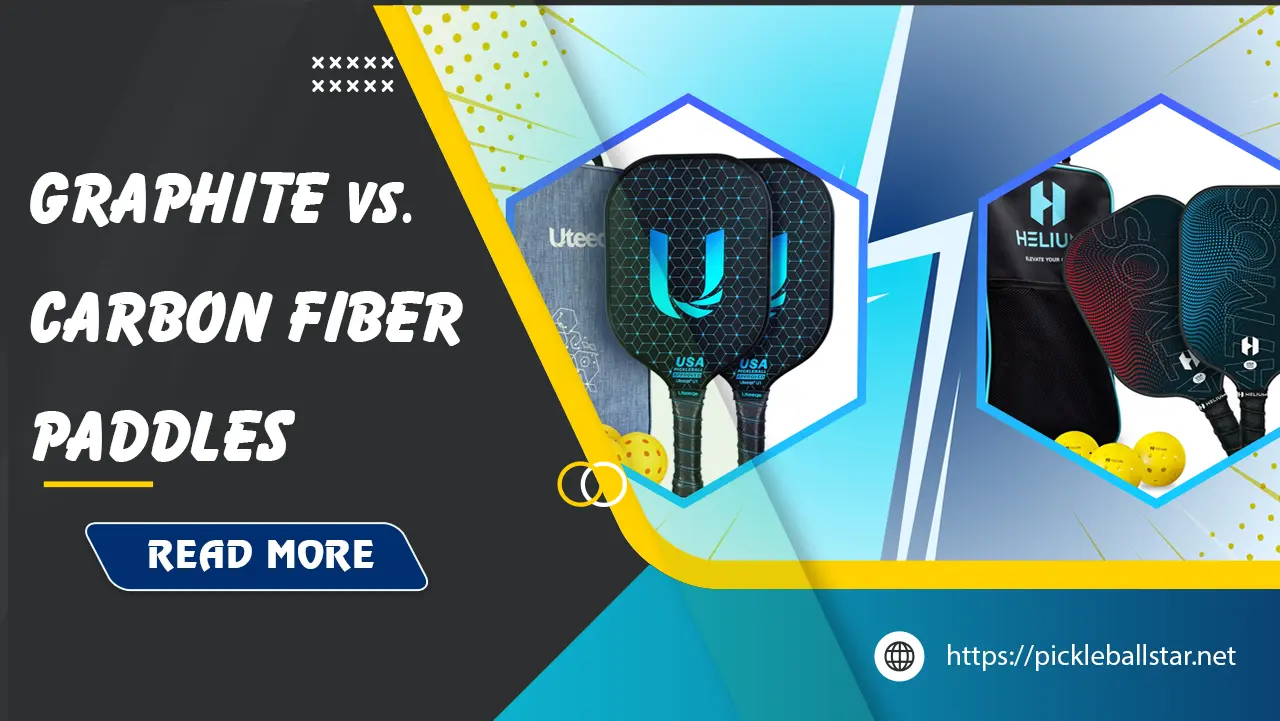Carbon Fiber vs Graphite Pickleball Paddles: Top Comparison
In the rapidly growing sport of pickleball, selecting the right paddle is crucial for enhancing your game. Two popular options among advanced players are carbon fiber and graphite pickleball paddles. Both materials offer unique benefits and characteristics. In this comprehensive guide, we will compare carbon fiber vs graphite pickleball paddles based on their construction, weight, durability, performance, cost, buying tips, maintenance, and address frequently asked questions.

Carbon Fiber vs Graphite Pickleball Paddles Construction
The construction of a pickleball paddle significantly affects its performance and durability. Let’s delve into the construction of carbon fiber and graphite paddles, focusing on paddle face materials and core materials.
Paddle Face Materials
- Carbon Fiber: Carbon fiber faces are made from woven strands of carbon that provide exceptional strength and stiffness. This material is lightweight yet incredibly durable, offering excellent control and touch.
- Graphite: Graphite faces are made from sheets of carbon atoms arranged in a lattice structure. Graphite is also lightweight and strong but typically offers a slightly softer feel than carbon fiber. Graphite paddles provide a balance of power and control.
Core Materials
Both carbon fiber and graphite paddles typically use similar core materials, which significantly influence the paddle’s overall performance:
- Polymer Core: The most popular choice due to its balance of power, control, and noise reduction. Polymer cores, often in a honeycomb structure, provide a softer feel and absorb vibrations well.
- Nomex Core: Made from aramid fiber, Nomex cores are known for their durability and power. They are slightly louder but offer a crisp, responsive feel, making them ideal for aggressive players.
- Aluminum Core: Aluminum cores provide excellent control and precision. They are stiffer and heavier than polymer cores, offering solid feedback and enhanced accuracy.
Weight
The weight of a pickleball paddle affects its maneuverability, power, and control. Both carbon fiber and graphite paddles are available in various weight categories:
- Lightweight (6.5-7.2 ounces): Lightweight paddles are easy to maneuver and less tiring to use. They are ideal for players who rely on quick reactions and finesse.
- Midweight (7.3-8.4 ounces): Midweight paddles offer a balance between power and control. They are versatile, providing enough heft for powerful shots while remaining manageable for quick exchanges.
- Heavyweight (8.5+ ounces): Heavyweight paddles deliver maximum power but can be more challenging to maneuver quickly. They are best suited for players who prioritize strength and drive in their game.
Durability and Lifespan
- Carbon Fiber: Carbon fiber paddles are renowned for their durability. The strong, woven carbon fibers provide resistance to wear and tear, making these paddles suitable for frequent and intense play. With proper care, carbon fiber paddles can last several years.
- Graphite: Graphite paddles are also highly durable, though they might not be as resistant to impacts as carbon fiber paddles. The lattice structure of graphite provides excellent strength, but the softer feel can result in slightly less durability over time compared to carbon fiber. Nevertheless, graphite paddles can also have a long lifespan with proper maintenance.
Performance Analysis
Control
- Carbon Fiber: Known for its stiffness, carbon fiber provides superior control and touch. The rigidity of the material allows players to place shots precisely.
- Graphite: Graphite offers a balance of control and power, with a slightly softer feel than carbon fiber. This makes graphite paddles versatile for players who want a mix of touch and strength.
Power
- Carbon Fiber: Carbon fiber paddles can generate substantial power, especially when paired with a core like Nomex. The stiff face material contributes to strong, powerful shots.
- Graphite: Graphite paddles also deliver good power but tend to offer a bit more flex, which can result in slightly less immediate power compared to carbon fiber.
Spin
- Carbon Fiber: The textured surface of carbon fiber paddles can enhance spin capabilities, making them ideal for players who frequently use spin shots.
- Graphite: Graphite paddles also support spin well, though the feel might be slightly different. Both materials are effective for spin, depending on the paddle’s design.
Feel
- Carbon Fiber: Often described as solid and crisp, carbon fiber paddles provide immediate feedback, which is crucial for advanced players who rely on precision.
- Graphite: Graphite paddles offer a softer feel, which can be more forgiving on the joints and muscles, making them comfortable for extended play.
Cost
- Carbon Fiber: Carbon fiber paddles are generally more expensive due to the high cost of materials and advanced manufacturing processes. Prices typically range from $100 to $200 or more, depending on the brand and specific features.
- Graphite: Graphite paddles are also priced at a premium but are often slightly less expensive than carbon fiber. Prices usually range from $80 to $150, making them a more affordable option for players seeking high performance without breaking the bank.
Buying Guide
When choosing between carbon fiber and graphite pickleball paddles, consider the following factors:
Skill Level
- Beginner: Beginners might prefer graphite paddles for their balance of power and control at a slightly lower cost.
- Intermediate: Intermediate players can benefit from either material, depending on their playing style and preference for feel and performance.
- Advanced: Advanced players often choose carbon fiber paddles for their superior control and power, though graphite paddles remain a viable option for those seeking a softer feel.
Playing Style
- Power Players: Carbon fiber paddles with Nomex cores provide the maximum power and stiffness.
- Control Players: Graphite paddles with polymer cores offer excellent control and a softer feel.
- All-Rounders: Both materials can suit all-round players; choosing between them depends on personal preference for feel and specific performance needs.
Additional Features
- Edge Guard: Protects the paddle from damage and extends its lifespan.
- Grip Size: Ensure the grip size is comfortable for your hand to avoid fatigue and improve control.
- Textured Face: Enhances spin capability, useful for players who use spin shots frequently.
Maintenance
Proper maintenance is crucial for extending the lifespan of your pickleball paddle, regardless of whether it is made from carbon fiber or graphite.
- Cleaning: Regularly clean the paddle face with a damp cloth to remove dirt and debris. Avoid using harsh chemicals that can damage the materials.
- Storage: Store your paddle in a cool, dry place. Avoid leaving it in extreme temperatures or direct sunlight, which can warp or damage the materials.
- Edge Guard: Inspect the edge guard for any signs of wear or damage. Replace it if necessary to protect the paddle’s core and face.
- Grip: Over time, the grip may wear out. Replace the grip or use an overgrip to maintain a comfortable and secure hold.
- Inspection: Periodically check for any cracks or delamination in the paddle face and core. Address any issues promptly to prevent further damage.
FAQs
Which is better: carbon fiber or graphite pickleball paddles?
The choice between carbon fiber and graphite depends on your playing style and personal preferences. Carbon fiber paddles offer superior control and power, while graphite paddles provide a balanced feel with a softer touch.
Are carbon fiber paddles more expensive than graphite paddles?
Generally, yes. Carbon fiber paddles tend to be more expensive due to the high cost of materials and advanced manufacturing processes.
Can beginners use carbon fiber or graphite paddles?
Absolutely. Both materials are suitable for beginners, though graphite paddles might be more accessible due to their slightly lower cost and balanced performance.
How do I clean my pickleball paddle?
Use a damp cloth to clean the paddle face regularly, avoiding harsh chemicals that can damage the materials. Proper storage and maintenance can also extend the paddle’s lifespan.
What core material is best for carbon fiber and graphite paddles?
Polymer cores are the most popular due to their balance of power, control, and noise reduction. Nomex cores offer more power and durability, while aluminum cores provide excellent control and precision.
Conclusion
Both carbon fiber and graphite pickleball paddles offer unique benefits that can enhance your game. Carbon fiber paddles are known for their superior control, power, and durability, making them a top choice for advanced players. Graphite paddles, on the other hand, provide a balanced feel with a softer touch, making them suitable for players of all levels. By understanding the differences in construction, weight, performance, and cost, you can make an informed decision and choose the paddle that best suits your playing style and preferences. Proper maintenance will ensure that your chosen paddle remains in top condition, allowing you to enjoy the game to its fullest.
